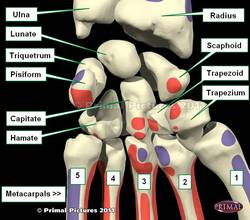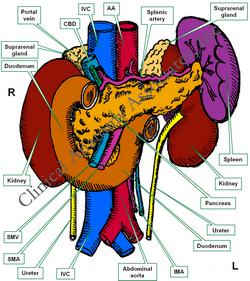
Medical Terminology Daily (MTD) is a blog sponsored by Clinical Anatomy Associates, Inc. as a service to the medical community. We post anatomical, medical or surgical terms, their meaning and usage, as well as biographical notes on anatomists, surgeons, and researchers through the ages. Be warned that some of the images used depict human anatomical specimens.
You are welcome to submit questions and suggestions using our "Contact Us" form. The information on this blog follows the terms on our "Privacy and Security Statement" and cannot be construed as medical guidance or instructions for treatment.
We have 396 guests online

Georg Eduard Von Rindfleisch
(1836 – 1908)
German pathologist and histologist of Bavarian nobility ancestry. Rindfleisch studied medicine in Würzburg, Berlin, and Heidelberg, earning his MD in 1859 with the thesis “De Vasorum Genesi” (on the generation of vessels) under the tutelage of Rudolf Virchow (1821 - 1902). He then continued as a assistant to Virchow in a newly founded institute in Berlin. He then moved to Breslau in 1861 as an assistant to Rudolf Heidenhain (1834–1897), becoming a professor of pathological anatomy. In 1865 he became full professor in Bonn and in 1874 in Würzburg, where a new pathological institute was built according to his design (completed in 1878), where he worked until his retirement in 1906.
He was the first to describe the inflammatory background of multiple sclerosis in 1863, when he noted that demyelinated lesions have in their center small vessels that are surrounded by a leukocyte inflammatory infiltrate.
After extensive investigations, he suspected an infectious origin of tuberculosis - even before Robert Koch's detection of the tuberculosis bacillus in 1892. Rindfleisch 's special achievement is the description of the morphologically conspicuous macrophages in typhoid inflammation. His distinction between myocardial infarction and myocarditis in 1890 is also of lasting importance.
Associated eponyms
"Rindfleisch's folds": Usually a single semilunar fold of the serous surface of the pericardium around the origin of the aorta. Also known as the plica semilunaris aortæ.
"Rindfleisch's cells": Historical (and obsolete) name for eosinophilic leukocytes.
Personal note: G. Rindfleisch’s book “Traité D' Histologie Pathologique” 2nd edition (1873) is now part of my library. This book was translated from German to French by Dr. Frédéric Gross (1844-1927) , Associate Professor of the Medicine Faculty in Nancy, France. The book is dedicated to Dr. Theodore Billroth (1829-1894), an important surgeon whose pioneering work on subtotal gastrectomies paved the way for today’s robotic bariatric surgery. Dr. Miranda.
Sources:
1. "Stedmans Medical Eponyms" Forbis, P.; Bartolucci, SL; 1998 Williams and Wilkins
2. "Rindfleisch, Georg Eduard von (bayerischer Adel?)" Deutsche Biographie
3. "The pathology of multiple sclerosis and its evolution" Lassmann H. (1999) Philos Trans R Soc Lond B Biol Sci. 354 (1390): 1635–40.
4. “Traité D' Histologie Pathologique” G.E.
Rindfleisch 2nd Ed (1873) Ballieres et Fils. Paris, Translated by F Gross
"Clinical Anatomy Associates, Inc., and the contributors of "Medical Terminology Daily" wish to thank all individuals who donate their bodies and tissues for the advancement of education and research”.
Click here for more information
- Details
This article is part of the series "A Moment in History" where we honor those who have contributed to the growth of medical knowledge in the areas of anatomy, medicine, surgery, and medical research.

Luigi Galvani
Luigi A. Galvani (1737-1798). Italian anatomist, surgeon, and physiologist, Luigi Aloisio Galvani was born in Bologna in 1737. Although he started his studies to join the church, Galvani followed with medical studies at the University of Bologna, where he became a skilled anatomist and surgeon. On July 15, 1759 Galvani obtained his degree in medicine and philosophy.
He was interested in the effects of electricity on tissues and through observation and experimentation he postulated the existence of "animal electricity", that is, electricity generated within the tissues. He postulated the possibility that nerves carried electricity. His theories led to a passionate controversy with Volta, who denied Galvani's postulates. Galvani's theories would only be confirmed after his death.
Galvani was deeply religious, and when forced by government officials to take an oath of atheism, he refused. He was stripped of his position and was lead to poverty. His position was restored close to his death. In his honor, Andre Ampere (1775-1836) named one of his inventions that measures electricity, the "galvanometer". His name is also present in vernacular English, when we say that a rock star or a movie "galvanizes" an audience, meaning it was "electrifying"!
Sources:
1. "Luigi Galvani" Haas LF J Neurol Neurosurg Psychiatry v.56(10); Oct 1993
2. "Luigi Galvani and the foundations of electrophysiology" Cajavilca C, Varonb,J,Sternbachc GL; Resuscitation 80 (2009) 159–162
- Details
The capitate bone is one of the four bones that comprise the distal row of the carpus or carpal bones that form the wrist. It is the largest of the carpal bones and is placed in the center of the wrist (see image).
Its name originates from the Latin [caput], meaning "head". The capitate bone presents a large, rounded area, called the "head". To complete the homology, the capitate bone also has a narrow segment called the "neck", the rest of the bone called the "body". It is also known as "os capitatum" or "os magnum"
The capitate bone articulates with seven bones, including the scaphoid, lunate, trapezoid, hamate, and the three central metacarpals (2nd, 3rd, and 4th).
The accompanying image shows the anterior (volar) surface of the wrist.
Image modified from the original: 3D Human Anatomy: Regional Edition DVD-ROM" Courtesy of Primal Pictures
- Details
The duodenum is a mostly retroperitoneal organ, part of the digestive tract, and the most proximal portion of the small intestine. This organ is approximately 10 inches in length (24.5 cm). It starts at the pylorus of the stomach, has a "C" shape, curving around the head and the neck of the pancreas, to end at the duodenojejunal junction.
The duodenum is described as having four segments of differing length, usually named numerically:
- First segment: about two inches in length, it is dilated and called the "duodenal ampulla", or "superior duodenum"
- Second segment: about three inches in length, it receives bile and pancreatic juice through the hepatopancreatic ducts and ampullae. It is also called the "descending duodenum"
- Third segment: about four inches in length, it crosses the midline, and is also known as the "horizontal" or "transverse duodenum"
- Fourth segment: one inch in length, this is the shortest segment, it ascends towards the duodenojejunal junction, which is tethered to the diaphragm by a fold of peritoneum around a fibromuscular band called the "ligament of Treitz". At this point the retroperitoneal duodenum becomes the intraperitoneal jejunum. This fourth segment is also called the "ascending duodenum"
The name of the organ is interesting. Most textbooks claim that is originates from the Latin [duodeni], meaning "twelve". The fact is that the duodenum was originally named in Greek [δώδεκα δάχτυλαν] meaning "twelve fingers". If you place both your hands together and add 1/4 of an inch to each side (as if you had an extra finger on each hand) that measures approximately 10 inches. The term was shortened by an incorrect translation to "twelve" by Gerard of Cremona (1114 - 1187) who called it "duodenum", a bad translation, as twelve fingers in Latin is [duodecim digitorum].
While most of the duodenum is retroperitoneal, the first inch of the superior duodenum (first segment) is intraperitoneal as it shares a small portion of the lesser omentum with the stomach and liver.
Sources:
1. "Clinically Oriented Anatomy" Moore, KL. 3r Ed. Williams & Wilkins 1992
2. "The origin of Medical Terms" Skinner, AH, 1970
Image property of: CAA, Inc. Artist: Dr. E. Miranda
- Details
This prefix is derived from the Greek and means "slow". Most everybody knows about [bradycardia] meaning "slow heart", but there is a large number of applications of this prefix as follows:
- Bradytrophia: from the Greek [trophe] meaning "to feed" or "nutrition". Braditrophia is a slow nutritional process
- Bradypnea: from the Greek [pnoia], meaning "breath" or "air". Bradypnea is an abnormally slow breathing rhythm
- Bradylalia: from the Greel [lalein] meaning "to talk". Bradylalia is a slow articulation or formation of words, sometimes also known as [bradyarthria] or [bradyphasia]. See the article on aphasia and dysphasia here
- Bradykinesia: from the Greek [kinesis], meaning "movement". Bradykinesia means "slow movement", also known as [bradypragia]
- Bradycrotic: from the Greek [krotos], meaning "pulse" "or pulsation" A bradycrotic agent slows down the patient's pulse or heart rate.
- Bradytocia: from the Greek [tokos], meaning "birth". Bradytocia is a slow birthing process
- Details
The word [bregma] is Greek and means "the front of the head". It is actually the point of intersection of the the coronal and sagittal sutures. The coronal suture is the articulation or joint between the frontal and parietal bones, and the sagittal suture is the median joint between both parietal bones.
The term was first used in anatomy as a craniometric point by Paul Broca (1824 - 1880). The image shows a superior view of two heads and the location of the coronal and sagittal sutures. The bregma is the point of intersection of these two articulations.
Click on the image for a larger view. 1 = coronal suture 2 = sagittal suture 3 = lambdoid suture. The bregma is the point of intersection of 1 and 2
Original image courtesy of Wikipedia
- Details
This article is part of the series "A Moment in History" where we honor those who have contributed to the growth of medical knowledge in the areas of anatomy, medicine, surgery, and medical research.

Original image courtesy of
Images from the History of Medicine
Marie-Francois Xavier Bichat (1771 - 1802). French physician, surgeon, anatomist and physiologist, Marie-Francois Xavier Bichat was born in the village of Thoirette. His father was a physician, influencing his early instruction and vocation. In Lyon he studied anatomy and surgery. At 28 years of age Bichat was appointed physician to the Hôtel (Hospital) Dieu. His life was influenced by his mentor, Pierre-Joseph Dassault (1738 - 1795). Upon his mentor's death Bichat took upon him to continue and finish his work, while supporting his mentor's family.
Bichat is know for the concept of the body composed of distinct tissues, which he originally called "membranes". Without the aid of the microscope Bichat described 21 different tissues and is considered the founder of the science of histology. His name is preserved in many eponymic structures such as Bichat’s fossa (pterygopalatine fossa), Bichat’s buccal fat pad, Bichat’s foramen (cistern of the vena magna of Galen), Bichat’s ligament (lower fasciculus of the posterior sacroiliac ligament), and Bichat’s tunica intima (tunica intima vasorum).
Xavier Bichat also contributed to a newer description of the humoral physiological theory, later becoming the basis of hematology. He was also interested in the description of life and death, proposing the existence of an "organic life" and an "animal life". An interesting note is that Bichat died because of an infection he acquired while dissecting a cadaver. Remember that at the time, no embalming was used!
Today Bichat's name is almost forgotten, although in some countries the buccal fat pad is still called "Bichat's fat pad" In many Spanish-speaking countries this structure is referred to as "la bola grasa de Bichat", and many still refer to the removal of this fat pad as "Bichectomy". For an image of the before and after of the procedure, click here.
Sources:
1. "Marie-Fran?ois Xavier Bichat (1771-1802) and his contributions to the foundations of pathological anatomy and modern medicine" Shoja M.M., Tubbs R.S., Loukas M., Shokouhi G., Ardalan M.R.(2008) Annals of Anatomy, 190(5),413-420
2. "Physiological Researches on Life and Death" Bichat, Marie-Francois Xavier, 1827. Translated from French by F. Gold. Richardson and Lord, Boston.
3. "A Historical Perspective: Infection from Cadaveric Dissection from the 18th to the 20th Centuries" Shoja, MM et al. Clin Anat (2013) 26:154-160




